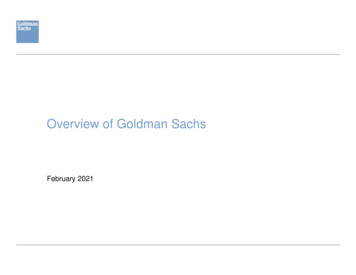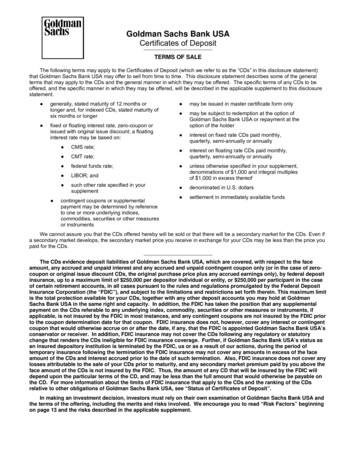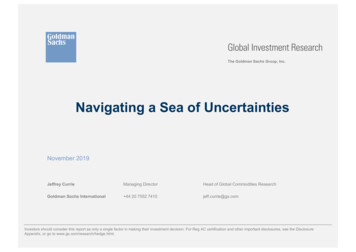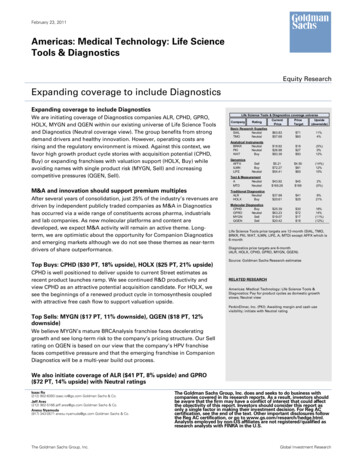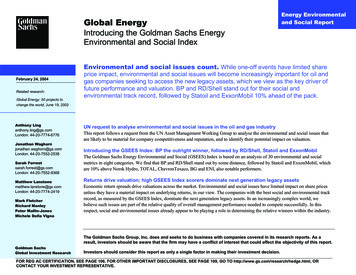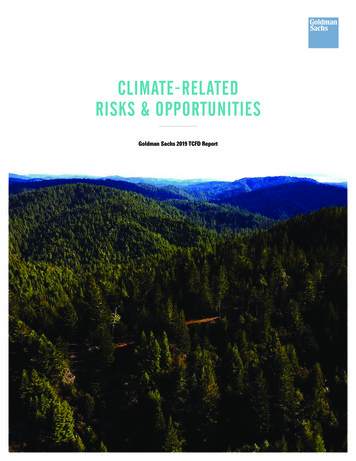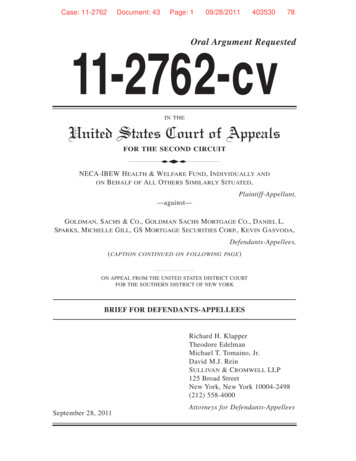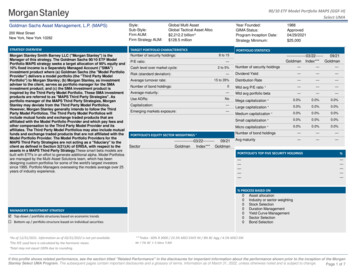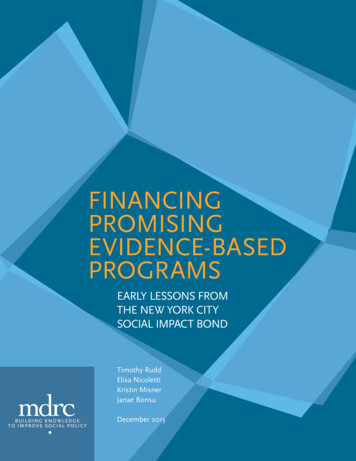
Transcription
2015ANNUAL REPORTTHE GOLDMAN SACHS GROUP, INC.
The Goldman Sachs Business PrinciplesOur clients’ interestsalways come first.Our experience shows that if weserve our clients well, our ownsuccess will follow.Our assets are our people,capital and reputation.If any of these is ever diminished, thelast is the most difficult to restore. Weare dedicated to complying fully withthe letter and spirit of the laws, rulesand ethical principles that govern us.Our continued success depends uponunswerving adherence to this standard.Our goal is to provide superiorreturns to our shareholders.Profitability is critical to achievingsuperior returns, building our capital,and attracting and keeping our bestpeople. Significant employee stockownership aligns the interests of ouremployees and our shareholders.We take great pride in theprofessional quality of our work.We have an uncompromisingdetermination to achieve excellencein everything we undertake. Thoughwe may be involved in a wide varietyand heavy volume of activity, wewould, if it came to a choice, ratherbe best than biggest.We stress creativity andimagination in everything we do.While recognizing that the old way maystill be the best way, we constantlystrive to find a better solution to aclient’s problems. We pride ourselveson having pioneered many of thepractices and techniques that havebecome standard in the industry.We make an unusual effort toidentify and recruit the very bestperson for every job.Although our activities are measured inbillions of dollars, we select our peopleone by one. In a service business,we know that without the best people,we cannot be the best firm.We offer our people the opportunityto move ahead more rapidly than ispossible at most other places.Advancement depends on merit andwe have yet to find the limits to theresponsibility our best people are ableto assume. For us to be successful,our men and women must reflect thediversity of the communities and culturesin which we operate. That meanswe must attract, retain and motivatepeople from many backgrounds andperspectives. Being diverse isnot optional; it is what we must be.We stress teamworkin everything we do.While individual creativity is alwaysencouraged, we have found that teameffort often produces the best results.We have no room for those who put theirpersonal interests ahead of the interestsof the firm and its clients.The dedication of our people tothe firm and the intense effortthey give their jobs are greaterthan one finds in most otherorganizations.We think that this is an importantpart of our success.We consider our size an assetthat we try hard to preserve.We want to be big enough to undertakethe largest project that any of our clientscould contemplate, yet small enough tomaintain the loyalty, the intimacy and theesprit de corps that we all treasure andthat contribute greatly to our success.We constantly strive to anticipatethe rapidly changing needs of ourclients and to develop new servicesto meet those needs.We know that the world of finance willnot stand still and that complacencycan lead to extinction.We regularly receive confidentialinformation as part of our normalclient relationships.To breach a confidence or to useconfidential information improperly orcarelessly would be unthinkable.Our business is highly competitive,and we aggressively seek to expandour client relationships.However, we must always be faircompetitors and must never denigrateother firms.Integrity and honesty areat the heart of our business.We expect our people to maintain highethical standards in everything they do,both in their work for the firm and intheir personal lives.
Fellow Shareholders:As many of you know first hand, 2015 was a tale of twohalves: the first half of the year featured a strong operatingenvironment, but headwinds emerged, particularly during thesecond half, and these headwinds persisted into early 2016.The first two quarters of 2015 were marked by heightened demand from ourcorporate clients for strategic advice and financings, strong client activity acrossour Equities franchise and growing demand from our Investment Managementclients for our products and services. These factors culminated in record first-halfresults in Investment Banking and Investment Management, as well as the bestfirst-half performance for Equities in six years.As the year progressed, increasing concerns about China,the first rate hike from the U.S. Federal Reserve in nearlya decade, slowing global growth and falling commodityprices — especially in oil — began to emerge. We facedthese headwinds, and lower client activity across manyof our businesses suggested that our clients and peersalso faced their share of challenges.In addition to the impact of the operating environment,our 2015 financial performance was negatively affectedby the resolution of our most significant outstanding legalexposure relating to our securitization, underwriting andsale of residential mortgage-backed securities (RMBS)from 2005 to 2007. In January 2016, we announced anagreement in principle with the RMBS Working Group,*under which we will pay a 2.39 billion civil monetarypenalty, make 875 million in cash payments and provide 1.80 billion in consumer relief.Despite these factors, our strong and diversified clientfranchise allowed us to produce relatively stable netrevenues in 2015. The firm generated net revenues of 33.82 billion, marking our fourth consecutive year ofroughly 34 billion in net revenues. Net earnings were 6.08 billion and diluted earnings per common sharewere 12.14. Return on average common shareholders’equity (ROE) was 7.4 percent for 2015, which wouldhave been 3.8 percentage points higher excluding theprovisions we recorded during the year related to theRMBS Working Group settlement.* On January 14, 2016, the firm announced an agreement in principle, subject to the negotiation of definitive documentation, to resolve the ongoing investigation of the Residential Mortgage-BackedSecurities Working Group of the U.S. Financial Fraud Enforcement Task Force (RMBS Working Group). The agreement in principle will resolve actual and potential civil claims by the U.S. Department ofJustice, the New York and Illinois Attorneys General, the National Credit Union Administration (as conservator for several failed credit unions) and the Federal Home Loan Banks of Chicago and Seattle,relating to the firm’s securitization, underwriting and sale of residential mortgage-backed securities from 2005 to 2007. For additional information, see the firm’s Form 8-K filed with the U.S. Securitiesand Exchange Commission on January 14, 2016.Goldman Sachs 2015 Annual Report1
Letter to ShareholdersLloyd C. BlankfeinChairman andChief Executive Officer(right)Gary D. CohnPresident andChief Operating Officer(left)In this year’s letter to our shareholders, we cover awide array of topics, including an overview of ourfinancial profile, a review of our strong and diverseclient franchise, as well as our thoughts on the forwardoutlook, particularly how we are thinking aboutnavigating these uncertain times.Financial ProfileAs we manage our financial profile, our strategy ispredicated on carefully delineating between structuraland cyclical factors affecting our businesses. Accordingly,in 2015, we continued to adjust our franchise to addressstructural changes in the regulatory environment, andwe will continue to do so as needed. From a cyclicalperspective, it certainly feels like the cycle has beenprolonged, particularly as interest rates in many partsof the world remain at — or even below — zero, andgrowth and deflation concerns, among other worries,have persisted.It is important to remember that cycles do turn, even ifthe timing of such inflections may be difficult to predict.As we look to deliver value to our shareholders over the2Goldman Sachs 2015 Annual Reportlong term, our focus continues to be on managing toboth the structural and cyclical forces we see at play,while remaining flexible enough to capture futuregrowth opportunities.Our efforts in this regard have yielded solid results. Overthe past four years, we have diversified our franchisewhile holding net revenues steady. We have increased ourcapital and liquidity, decreased our risk, and have stayedfocused on efficiently and prudently managing ourresources — all while helping our clients to execute theirlong-term goals and strategic objectives. Over the samefour-year period, we returned approximately 25 billionin capital to our shareholders, increased dividends percommon share by 44 percent and reduced our basicshare count by 14 percent.In response to structural changes resulting from newregulations, since the end of 2007, we have reducedour balance sheet by approximately one-quarter, whilenearly doubling common shareholders’ equity — cuttinggross leverage by more than 60 percent — and triplingour liquidity position to almost 200 billion. Thesemeasures have strengthened our long-term financialsafety and soundness.
Also as a result of structural changes, we have embracedopportunities to sell businesses and investments that werenot core to our client franchise and were no longer thebest use of shareholder capital relative to the returns.The loss in net revenues due to these sales has been offsetby growth in our Investment Banking and InvestmentManagement businesses. Last year, these two businessesaccounted for 39 percent of our net revenues, comparedto only 30 percent in 2012. Investment Banking wasapproximately one-half the size of Fixed Income,Currency and Commodities Client Execution (FICC) fouryears ago; today, our business mix is more balanced.while ensuring we meet the needs of our clients. Whetherwe are adjusting to structural or cyclical dynamics, wewill carefully balance our expense management effortsagainst our ability to capture future market share andgrowth opportunities.Investment BankingThis does not mean we are moving away from FICC.Rather, we remain committed to meeting the needs ofour clients, while managing to structural and cyclicalheadwinds. For example, we have reduced risk-weightedassets within FICC significantly over the past four years,largely in response to structural changes resulting fromnew regulations.Our leading Investment Banking franchise allowed us tocapture significant market share in 2015. The businessachieved its second-highest net revenues in 2015, drivenby a strong environment for mergers and acquisitions(M&A). Industry-wide volumes for announced M&Atransactions increased by more than 45 percent in 2015,while the firm’s volumes increased by approximately80 percent. We ended the year ranked first in globalannounced and completed M&A, with completedM&A volumes that were more than 350 billion higherthan our next-closest competitor — a record gap sincethe firm went public.On the cost side, we have continued to find ways toimprove our operating efficiency. Headcount acrossthe firm is up 11 percent over the last four years, largelyto meet regulatory compliance needs. However, througha combination of shifting to a greater percentage ofjunior employees and relocating some of our footprintto lower-cost locations, we have managed ourexpenses well.By most measures, 2015 was a robust year forM&A. However, volumes as a percentage of marketcapitalization are still below prior-cycle peak levels.We see this as a sign that there is still some room to runfor M&A activity, particularly when equity marketsshow signs of sustained stabilization. We also seeconsolidation opportunities in sectors such as industrials,energy, mining, food, media and telecommunications.More specifically, we have increased the number ofanalysts, associates and vice presidents at the firm by17 percent since the beginning of 2012, while our partnerand managing director populations have decreased bytwo percent. Approximately 25 percent of our total staffis now in lower-cost locations such as Salt Lake City,Dallas, Irving, Warsaw, Singapore and Bengaluru. Asa result, while total staff levels are up over the four-yearperiod, overall compensation and benefits expenseshave declined by approximately 270 million.While total underwriting revenues declined in 2015,we performed relatively well in the context of softerequity and debt markets in the second half of the year.We finished 2015 ranked first in global equity andequity-related and common stock offerings. Similar tothe dynamics we see in the M&A market, we believethere may be pent-up demand among our corporateclients to tap into public equity markets when conditionsimprove, particularly given that private financingconditions have generally tightened. A decline in debtunderwriting net revenues in 2015 was largely due toa drop in leveraged finance activity.Looking ahead, we will continue to pursue ways to bemore cost effective by assessing our expense structureGoldman Sachs 2015 Annual Report3
Letter to ShareholdersInstitutional Client ServicesInvesting & LendingIn the wake of balance sheet restructurings in theU.S. and elsewhere, we remain one of the few financialinstitutions with leading global franchises in both FICCand Equities. We view this as critical to the long-termsuccess of our Institutional Client Services business.We expect our ability to offer our clients a broad suiteof services to be a key competitive advantage in theyears ahead.Our Investing & Lending business enhances and expandsour client relationships. It creates synergies for ourbroader client franchise because it enables us to extendcredit or to invest alongside our clients. From a broaderperspective, by participating in Investing & Lending ina disciplined manner, we engage in the capital allocationprocess, which allows corporates and individuals to putcapital to work to generate broader economic growth.Over the course of 2015, within FICC, lower levelsof client activity in credit and mortgage products werepartly offset by stronger client activity and a morefavorable backdrop for macro products, particularlyin interest rates and currencies.Over the past several years, the composition of Investing& Lending has changed significantly. Since the beginningof 2012, we have seen lending increase threefold,primarily to private wealth management and corporateclients. Our corporate loan portfolio is well diversified,with no one sector representing more than one-quarterof the portfolio. Our private equity portfolio similarlyreflects the diversity of our global client franchise,comprising more than 800 different investments globallyacross a broad spectrum of industries. In some cases, weinvest in private companies alongside our clients. In othercases, we invest in public equity or in real estate, or wedeploy capital to seed new funds.Equities benefitted from a better market environment,posting solid results for the year. Clients continued toplace significant value on the integration of our variousservices across Equities — electronic, cash, derivativesand prime brokerage — as well as our global footprint,all of which was reflected in our performance inthese areas.Moving forward, addressing structural changes in ourInstitutional Client Services businesses, such as riskbased capital rules, will remain a central focus for ourmanagement team. At the same time, we will look forways to advance our franchise in the evolving landscape.Competitor retrenchments in the wake of structuraldevelopments should provide an opportunity for us tocapture market share over the longer term.As it pertains to cyclical trends in Institutional ClientServices, we continue to carefully scale our businessrelative to the environment, but have also chosen toremain targeted in our efforts. Our business is highlycorrelated to economic growth, and when a betteropportunity set eventually presents itself — and itwill — our strong, deep and broad client franchiseshould position us well to respond.4Goldman Sachs 2015 Annual ReportWhile the nature of our investing may change over timedue to regulatory changes, and net revenues can fluctuatefrom quarter to quarter based on price movements, weevaluate the performance of our Investing & Lendingportfolio over many years. On that basis, these activitieshave been strong contributors to returns over the lastfour years.Investment ManagementOur Investment Management business is one of onlya few such franchises globally that can meet the needsof a broad spectrum of clients across many products andregions. We serve investors of all types, including retireesin need of mutual funds, entrepreneurs who have soldtheir companies and pension fund managers who needhelp with asset allocation. With this in mind, we built
our business to be global, broad and deep, and to focuson delivering consistent returns over time. We believethat our emphasis on providing the best possible advice,products and services will help us outperform theindustry over time.Executing on this strategy, we have experiencedsignificant growth in our business over the past severalyears. We ended 2015 with a record 1.25 trillion inassets under supervision, up from 895 billion at thestart of 2012. This growth has been the direct resultof robust net inflows, driven in part from market sharegains, as clients place increasing value on asset managerslike us that offer a broad array of products and services.In 2015, our 53 billion in organic, long-term net inflowsoutperformed our largest active management peers.In some areas of asset management, we are still smallrelative to the market leader. As we look ahead, thismeans we see opportunity to grow substantially — bothby continuing to gain market share in our incumbentbusinesses and by expanding into new ones.Our growth in assets under supervision has also comefrom new products and several strategic acquisitions.We have launched a handful of new products thathave added more than 50 billion to our assets undersupervision over the past four years. Our Active Beta,Unconstrained Fixed Income and Income OrientedStrategies funds, for example, offer our clients compellingnew opportunities.What’s more, eight acquisitions since the beginningof 2012 have driven more than 70 billion in inflows.These acquisitions have added important new capabilities,filled gaps in our asset management offering and addedscale to our current business. For example, in 2015,we acquired Imprint Capital Advisors, a dedicatedenvironmental, social and governance investmentadvisor, strengthening our ability to help our clientsaddress these considerations in their portfolios.Looking to build upon these efforts, we will continueto evaluate targeted strategic acquisition opportunitiesas they arise.Impact InvestingOur firm is committed to fostering meaningful changein the global economy, and in the communities in whichwe live and work, both through our core businesses, andby engaging in other activities that leverage our expertiseto promote economic progress. This means, among otherthings, helping new enterprises succeed and grow byinvesting in entrepreneurs, and helping to financedifferent types of projects across the globe, such as thosethat can improve living standards within traditionallyunderserved communities. It also means being mindfulof the environment’s importance, not only to society asa whole, but also to economic growth, and driving thatcore belief through our work with our clients and withinthe management of our own operations.Urban Investment GroupWe have a long history of innovative impact investingthrough our Urban Investment Group (UIG). Since2001, UIG has committed more than 4.9 billion tounderserved U.S. communities, facilitating the creationand preservation of over 20,000 housing units — themajority of which are affordable for low- to middleincome families — as well as more than 1.9 millionsquare feet of community space and over 6 millionsquare feet of commercial, retail and industrial facilities.We work with local stakeholders from the nonprofit,for-profit and public sectors, focusing on communityand economic development. We have also been a pioneerin the creation of “social impact bonds,” which arefinancial instruments that leverage private investmentsto support high-impact social programs. In fact, wewere involved in four of the eight social impact bondfinancings that have been launched in the U.S.Goldman Sachs 2015 Annual Report5
Letter to ShareholdersEnvironmental ImpactWe were among the first global financial institutionsto acknowledge the scale and urgency of the challengesposed by climate change when we established ourEnvironmental Policy Framework in 2005. A decadelater, we have continued to build on our commitmentto environmental stewardship, making it a part of ourcore mission to deploy financial solutions and drivemarket opportunities that help to address climate change.Specifically, to facilitate the transition to a low-carboneconomy, last year we updated our Environmental PolicyFramework to include an increased target of 150 billionin clean energy financings and investments by 2025, upfrom an earlier target of 40 billion. Finally, we continueto be mindful of our own operational impact on theenvironment, pledging to be carbon neutral from2015 onwards and to target 100 percent renewablepower to meet our global electricity needs by 2020.10,000 WomenSince its launch, this initiative has provided morethan 10,000 women from across 56 countries —including Afghanistan, Egypt, Rwanda, Brazil, Indiaand China — with business and management education,mentoring and networking, and access to capital. Aftercompleting the program, nearly 70 percent of surveyedgraduates have increased their revenue, 60 percent haveadded new jobs and most have doubled the size of theirworkforces. What’s also encouraging is the “multipliereffect”: 90 percent of our graduates have “paid itforward” by mentoring and teaching business skillsto other women in their communities.In 2014, The Goldman Sachs Foundation andInternational Finance Corporation, a member of theWorld Bank Group, launched the first-ever global financefacility dedicated exclusively to women-owned smalland medium-sized enterprises. To date, the facility hasmade more than 400 million in commitments to banksin 14 countries, enabling women from Kenya to Chinato Laos to access capital and grow their businesses. In6Goldman Sachs 2015 Annual Report2015, President Obama announced a 100 millioncommitment by the Overseas Private InvestmentCorporation, demonstrating how the facility is catalyzingnew investments from both the public and private sectorsin women-owned enterprises globally.10,000 Small BusinessesDesigned to help small businesses grow and create jobsby providing entrepreneurs with a practical businesseducation and access to capital, 10,000 Small Businesseshas served more than 6,000 small business owners at30 sites across the U.S. and the U.K. This includes ourcommitment of more than 180 million to 28 capitalpartners that have lent over 120 million to date,resulting in more than 750 loans to small businesses.The program has maintained a 99 percent graduationrate, with more than 75 percent of surveyed participantsincreasing their revenues, and nearly 60 percentgenerating new jobs within 18 months of graduation.Focus on TechnologyTechnology underpins everything we do. In fact,approximately one quarter of our total staff works intechnology, which demonstrates just how critical it hasbecome to our strategy in several ways.First and foremost, technology enhances the overallexperience and quality of service we are able toprovide to our clients. It allows us to execute transactionsmore quickly and seamlessly, to provide better marketanalytics, data and other information, and tocommunicate faster and more efficiently.Second, technology helps us to operate more efficientlyas a firm. For example, relying more on open source andcloud strategies has helped us reduce vendor expensesfor our workplace application infrastructure productsand market data sources.Third, technology helps us meet new regulatoryrequirements, such as Dodd-Frank implementation andBasel III provisions. We have hired more technology
staff to build and adapt software and to automate suchprocesses, which would have otherwise been highlymanual and substantially more time intensive. Oncewe have fully embedded technology solutions for ourregulatory needs, we should be able to reduce or redirectresources to support other areas of our firm.Finally, the technology we create or develop inside ofGoldman Sachs can be a stand-alone product. We havea successful track record in this regard, with Tradeweb,DirectEdge and Markit as examples of platforms wedeveloped or participated in creating, and then monetized.Today, new platforms such as Symphony and Marqueeare helping our clients communicate, manage risk andbetter analyze their investments. Symphony is anindependent company built around core technologydeveloped and contributed by Goldman Sachs. ForMarquee, we built a common application developmentplatform, allowing our businesses to create sophisticatedtools that deliver cutting-edge capabilities to ourinstitutional investing clients.Our PeopleIn a rapidly evolving and highly competitive industrylike ours, technology is clearly a critical differentiator.Yet the quality of our talent remains a vital competitiveadvantage for us — if not the vital competitive advantagewe maintain.Ours is a business of relationships. This is the casenot only in our work with clients, but also here withinthe firm. To that end, Goldman Sachs goes to greatlengths to employ the best people with a wide rangeof experience and backgrounds. In 2015, we extendedoffers to 4 percent of applicants for open positions,and more than 80 percent of those offered roles choseto join the firm.As we compete for talent not only with other financialfirms, but also across other industries, particularly intechnology, we strive to remain a place where top talentaspires to work. We believe our time-tested culture ofclient service, teamwork and excellence sets usapart in this regard, and we find that people cometo Goldman Sachs because the nature of our work isfundamentally consequential to the world around them.By helping to allocate capital, manage risk and provideproducts, services and advice to a broad array of clients,Goldman Sachs plays a vital role in the economyacross industries and regions, something that isinherently appealing to people who want to affectpositive outcomes.With this in mind, we are proud that we were onceagain recognized as an employer of choice acrossa wide variety of metrics on Fortune magazine’s“100 Best Companies to Work For” and “MostAdmired Companies.” We were also pleased to againbe named as one of Working Mother magazine’s“100 Best Companies” and “Best Companies forMulticultural Women.”Attracting and retaining the highest-caliber talent alsomeans that we must invest in our people early on intheir careers — the best of whom will become the nextgeneration of leadership at the firm. Building off thelearnings of our biennial People Survey, last year weunveiled a set of new initiatives designed to supportjunior employees, giving them more flexibility andgreater exposure to our client franchise. In 2015, wealso selected our newest class of managing directors.In addition to hailing from more than 40 countries,40 percent of the class of 2015 started at the firm asanalysts, a testament to our emphasis on talentdevelopment and retention for the long haul.Looking AheadAs we look ahead, the question that is top of mind notonly to our clients, but also to Goldman Sachs, is: howdo we think about navigating these uncertain times?Since the second half of 2015, concerns about globaleconomic growth, investor sentiment, and regulatoryand monetary policy — in tandem with otherGoldman Sachs 2015 Annual Report7
Letter to Shareholdersmacroeconomic and geopolitical dynamics — havemade for pervasive uncertainty. Slowing growth in China,a presidential election in the U.S., a referendum in theU.K. about its future in the European Union, volatilityin the markets and regions consumed by conflict, to namea few, are examples of issues that are naturally generatingunease. Other fundamental questions being raised —from whether technology is permanently displacing jobsto whether monetary policy has reached its limits inaffecting economic outcomes — have gone from esotericto mainstream.At Goldman Sachs, we grapple with these questions dayin and day out. As managers of risk, we do our best tounderstand them, and to prepare our clients and ourfirm for even low-probability but highly consequentialscenarios. This is why we worry about deflationarypressures, or liquidity problems in financial markets asa result of new regulations, or how China will manageits transition from an infrastructure-driven to aconsumer-driven economy. It’s why we keep a close eyeon emerging markets, particularly those that lackdiversification and are heavily exposed to commodityexports, where a prolonged supply overhang couldnegatively affect prices for some time to come.When our clients confront these or other challenges,we use our institutional resources to help them navigatethe choppy waters, and we regularly consider how thesescenarios and other tail-risk events could directly affectour firm.While we must consistently try to “see around corners”to anticipate problems, we also see plenty of reasonsfor optimism. We see the U.S. nearing full employment,signs of modest inflation and some stabilization in equityand commodity markets. We don’t see how a worldof zero or negative interest rates could possibly be the“new normal.” Moreover, we view China’s slower rateof economic growth as still substantial, particularly giventhat it is now the world’s second-largest economy. We8Goldman Sachs 2015 Annual Reportsee room for continued fiscal policy expansion insome economies, and options for monetary policy ifmeaningful growth proves elusive.We can’t forecast every outcome, and we
Goldman Sachs 2015 Annual Report 1 As the year progressed, increasing concerns about China, the first rate hike from the U.S. Federal Reserve in nearly a decade, slowing global growth and falling commodity prices — especially in oil — began to emerge. We faced these headwinds, and lower client activity across many
